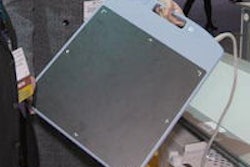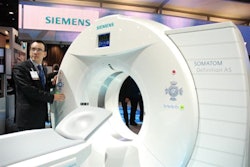An extraordinary number of tools to acquire and generate knowledge, along with nearly ubiquitous computing, have kicked off a new IT revolution. This will fundamentally alter society, much like the effects of the mainframe computer and the Internet.
This was one of several predictions that John Glaser, PhD, made at the keynote session of HIT X.0, a forward-looking lecture track at the Healthcare Information and Management Systems Society (HIMSS) annual meeting, held in Orlando, FL, last week. Glaser, the CEO of the health services business unit at Siemens Healthcare and recent advisor to Dr. David Blumenthal, the national coordinator for healthcare IT, shared the spotlight with Aneesh Chopra, the chief technology officer of the Obama administration, to offer "a glimpse at tomorrow's technology today."
A sea change is starting to occur, driven by society's alarm throughout the world at the cost of healthcare and the need to improve quality and reduce inappropriate treatments, Glaser said.
"This is a decade that has the nearest parallel to the 1960s and the impact of Medicare/Medicaid legislation," Glaser said. "The reimbursement environment will be fundamentally less generous for healthcare providers. To get whatever payment you are going to get, you'll have to show that you have earned your fees, through quality or efficiency measures. You'll be more at risk for performance for whatever you are going to get."
Glaser acknowledged that his audience was knowledgeable about data gathering and information sharing using the new technology tools being demonstrated in the mile-long Orange County Convention Center exhibition hall. But he questioned what they were going to do with it.
"Immediate opportunities sometimes are the least potent," he said. "Often the second- or third-tier opportunities become the most potent and have the greatest impact on change. Electronic health record [EHR] searching on the Internet is generating stunning amounts of data. People are now asking how to use this data to determine what's going on. How do I search the data? Generate hypotheses? Create usable information?"
In the future, software will be viewed and treated as a service, with a cost model to pay for it as it is consumed, Glaser predicted.
Data will be even more accessible without the requirement of physical proximity. Information technology will make it easier and faster to research issues that need to be investigated, and this may change medicine in ways that are not yet apparent, Glaser said.
People who need the data, or who use the results of data analysis, will be part of a community without the usual physical restraints. Virtual communities will exist for members to share information and to learn from each other's experiences, and these will proliferate.
One pioneering example is www.patientslikeme.com. This website was established in 2004 as an initiative of the family of a man with amyotrophic lateral sclerosis, or Lou Gehrig's disease, seeking ways to extend and improve his life. Over the past six years, the website has expanded into a platform for collecting and sharing real-world outcome-based patient data for numerous diseases and chronic, life-changing conditions.
With better access to more data, cause and effect should become easier to analyze because they can be investigated by anyone interested who has the authority and capability of doing so, Glaser suggested. Individual treatment tailored to a specific patient will be one outcome; it is already starting now. Physicians currently tailor cancer therapy to the average patient, but inroads are being made in delivering individualized cancer therapies based on patients' specific conditions and genes.
Data collection is expected to improve with the use of low-cost mobile monitors. Smartphones are being deployed to patients' homes to facilitate the monitoring of conditions, eliminating the need for a patient to visit a healthcare provider. These approaches are already providing better communication with clinical staff members, who, armed with data and current information, can deliver better, less costly care through timely intervention.
Revenue cycles will change because of disruptive innovation that will occur. "It is not perfectly clear what healthcare IT should do," Glaser noted. "There will be a lot of experimentation -- very evolutionary and very Darwinian. There will be challenges. Defining the degree of interoperability of clinical data is one of them."
But he pointed out that this process is much more complex than it's perceived to be. Glaser cited questions related to coordinating patient care among disparate healthcare organizations.
"What does care coordination look like from an IT perspective?" he asked. "What are the right tools and technologies needed by healthcare providers? What happens if a patient misses an appointment? What actions does this trigger?"
Following up on a missed appointment could have many nuances, he noted, and it requires the ability to differentiate different types of needs and being sensitive to the communication. An accidentally overlooked routine appointment for a screening exam by a healthy patient needs to be handled quite differently than follow-up for a patient with metastatic cancer, or for a patient who needed assistance to get to an appointment.
"Be prepared," Glaser said, challenging the audience. "We will need every bit of our collective energies to make our healthcare system a lot better."
Chopra: Think big; take action
"Today is the best time to be a healthcare entrepreneur in America," Chopra told his audience. The reason? The federal government is working to create a better climate for market-driven health improvements through the use of healthcare IT.
The Obama administration has enacted a three-pronged approach to innovation, the chief technology czar explained. In September 2009, President Obama unveiled a strategy that calls for a long-term look at the economic prospects for the U.S., Chopra explained.
The strategy has three basic pillars. The first is to invest in building blocks of innovation, research and development, and the country's infrastructure, both physical and digital. The strategy is also about human capital, with an emphasis on research, science and technology, engineering, and math training. The objective is to out-educate and out-innovate America's economic competitors around the world.
The second pillar is to establish the right conditions for market-based innovation. One example, according to Chopra, is the initiative to modernize the U.S. Patent and Trademark Office so patents can be processed within a year instead of three years.
The third pillar is to foster an "all-hands-on-deck" approach to inspire innovation. Chopra referenced a $3 billion innovation fund that would support projects such as "making sure that wireless communication can be fully leveraged in our healthcare ecosystem." He pointed out that $100 million is earmarked for healthcare innovations.
Chopra noted that a research grant given to a college professor has grown into an $80 billion IT budget for the use of cloud computing by the federal government. Obama wants to extend wireless service to 90% of the American people and position the U.S. to deliver on the fifth and sixth G revolutions that will occur because of investments in research and development.
"Social networking is an unstoppable phenomenon," Chopra said. "This is a trend that is permeating a whole range of innovation throughout our economic commercial engines."
As an example, he referenced the Red Balloon Challenge held by the Defense Advanced Research Projects Agency (DARPA) to mark the 40th anniversary of the Internet. "DARPA sponsored a high-tech scavenger hunt to explore how broad-scope problems could be tackled using social networking tools," he said. "The challenge was to identify the precise latitude and longitude of 10 red weather balloons released from undisclosed locations in the continental U.S. on December 5, 2009."
Hundreds of teams participated, but the Massachusetts Institute of Technology (MIT) team that won the challenge within nine hours following balloon launch had decided to enter only three days earlier. "Hundreds of thousands of people opened up their social networks to join the MIT team, an example of the collective problem-solving power of this IT technology," Chopra said.
"This is an era when the federal government is supporting healthcare IT innovation," he said. "Will you go forward and reach out to early adopters in January 2012 and engage them with products they need to build their future?"
When asked by Glaser to name ideas external to the healthcare industry that are applicable to it, Chopra named three:
- OpenTable: This restaurant reservation and availability Internet service defines the spirit of customer engagement -- simplicity of design, ease of engagement, and a good experience for the customer.
- The iPhone App store: This serves as a platform for innovation and substitutable applications.
- The Netflix approach to creating an iPhone App: The company made technical information available to external application developers to encourage new and creative ideas. They didn't presume to know the best interface to manage a movie queue, so they let others innovate and the market decide.
"You will see a lot of innovation and change in this industry," Chopra concluded.



















